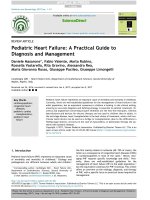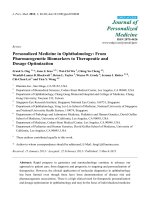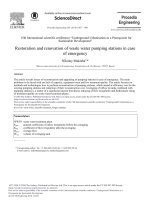Pediatric emergency medicine trisk 2606 2606
Bạn đang xem bản rút gọn của tài liệu. Xem và tải ngay bản đầy đủ của tài liệu tại đây (131.33 KB, 1 trang )
SEIZURES (SEE ALSO CHAPTER 72 SEIZURES )
Goals of Treatment
Most seizures in children are brief, lasting less than 5 minutes. Status epilepticus
(SE) was classically defined as seizures that are continuous for 30 minutes or
longer or repetitive seizures between which the patient does not regain
consciousness. Many authorities now consider that seizures lasting for longer
than 5 minutes or multiple seizures with no return to baseline in between
constitute early SE. Initial management of the child with a seizure is directed at
preventing neurologic damage through supportive care and seizure termination
with timely administration of antiepileptic drugs (AEDs), as well as identifying
any treatable underlying cause of the seizure.
CLINICAL PEARLS AND PITFALLS
Status epilepticus should be treated aggressively to minimize
neurologic damage.
Routine laboratory studies and acute neuroimaging are unnecessary
for the majority of children with first-time seizures.
Current Evidence
Epidemiologic studies indicate that 3% to 6% of children will have at least one
seizure in the first 16 years of life; most of these are simple febrile seizures,
which generally occur in children 6 months to 6 years old. A seizure is a transient,
involuntary alteration of consciousness, behavior, motor activity, sensation,
and/or autonomic function caused by an excessive rate and hypersynchrony of
discharges from a group of cerebral neurons. The term convulsion is often used to
describe a seizure with prominent motor manifestations. Epilepsy, or seizure
disorder, is a condition of susceptibility to recurrent seizures.
The basic pathophysiologic abnormality common to all seizures and
convulsions is the hypersynchrony of neuronal discharges. Many precipitating
factors, including metabolic, anatomic, and infectious abnormalities (see Chapter
72 Seizures ), may produce seizures. Seizures that result from an identified
precipitant are called symptomatic, or provoked, seizures, whereas those with no
precipitating factor are called idiopathic or cryptogenic. Febrile seizures (seizures
occurring in association with a febrile illness, without evidence of intracranial
infection or other identified cause) are a particular type of provoked seizure seen









